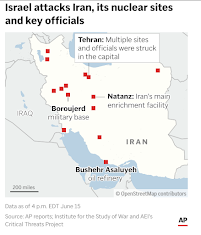The US-allied Netanyahu regime’s attack with warplanes and drones against Iran has sparked an open conflict between the two long-time foes that threatens to spiral into a wider, more dangerous regional war. Since Friday, Israeli strikes have killed more than 200 people in Iran, including top generals and scientists but also civilians. Iran has retaliated by launching hundreds of drones and missiles against Israel, some of which have penetrated Israel’s vaunted aerial defense system, killing two dozen people so far. Quite apart from the human toll, if war were to break out with Iran and the country were to descend into chaos, we could expect a significant increase in the looting and trafficking of ancient Iranian artefacts. This pattern has already been observed in regions destabilized by conflict, such as Iraq and Syria, where breakdowns in state control and heritage protection led to widespread pillaging of archaeological sites and museums.
Iran, with its exceptionally rich archaeological heritage, would be especially vulnerable. Many of the artefacts that might appear on the global market are already being trafficked to some extent, even in the absence of war. Many of them are ending up on the US market.
Among the types of artefacts most likely to surface are those from the Achaemenid period (c. 550–330 BCE), including imperial reliefs, cylinder seals, inscriptions in Old Persian cuneiform, and finely crafted gold and silver vessels. These objects are highly sought after for their associations with the grandeur of the ancient Persian Empire and their distinctive iconography. Material from the Elamite civilisation (c. 2700–539 BCE) would also be at risk. Though less well known, Elamite artefacts (such as bronze and terracotta figurines, ritual vessels, and inscribed tablets) have considerable appeal to collectors of ancient Near Eastern antiquities.
Artefacts from the Parthian and Sassanian periods (c. 247 BCE–651 CE) are likewise likely to be targeted, particularly silver vessels bearing royal motifs, coins, and decorative metalwork. Sassanian material has long circulated on the antiquities market and is often looted from tombs or hoards.
Iran's Islamic-era heritage would be vulnerable as well. This includes glazed ceramics such as lustreware, metalwork, architectural fragments, and especially Persian manuscripts (Qur’ans, scientific texts, poetry, and calligraphic works) which are already of high value on the international market.
Finally, prehistoric artefacts such as chlorite vessels, stone tools, and anthropomorphic figurines from sites such as Jiroft, Tepe Sialk, or Shahr-i Sokhta, have also appeared in increasing numbers in recent decades, often looted from burial sites and sold under vague or misleading labels.
Iranian authorities have already seized significant numbers of looted or illicitly trafficked antiquities in recent years, including coins, statuettes, and manuscripts. One major case involved the appearance of numerous chlorite vessels from the so-called Jiroft culture in the early 2000s, which suddenly flooded the market after widespread looting in the region. Other high-profile seizures have included fragments of Achaemenid reliefs, such as a Persepolis bas-relief confiscated in New York in 2017. Yet many more objects have undoubtedly slipped through customs controls and now reside in private collections or museum storerooms.
The experience of Iraq and Syria provides a grim precedent. In the wake of the 2003 invasion of Iraq, looters stripped archaeological sites, and museums were ransacked. Similarly, in Syria, various armed groups systematically looted sites for revenue. Some items were sold on the open market; others disappeared into private collections. Should the war escalate and Iran suffer a comparable collapse in heritage protection, it is likely that a similarly diverse range of high-value artefacts (particularly those with clear market demand) would appear in increasing numbers across the global antiquities trade and in the US.









No comments:
Post a Comment